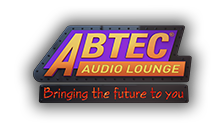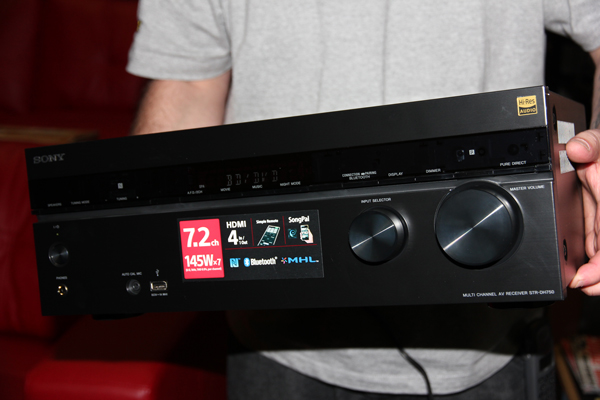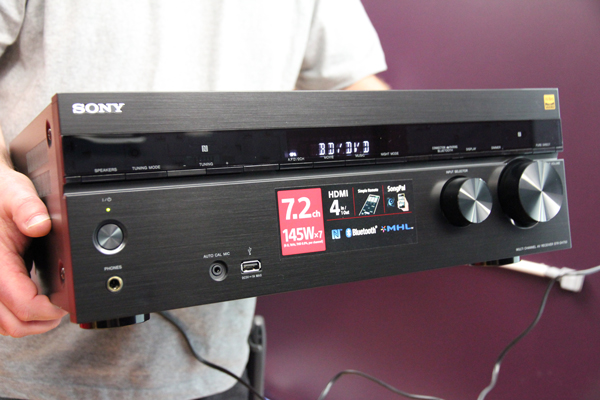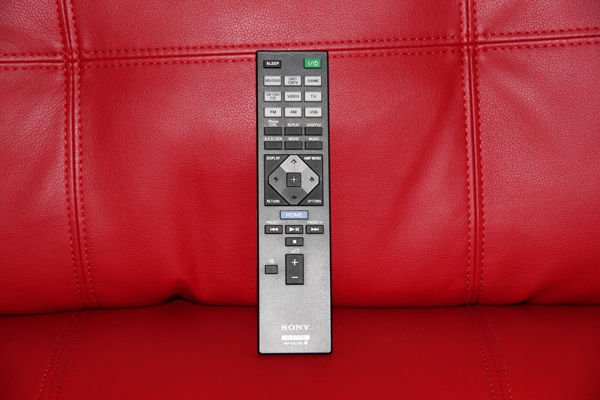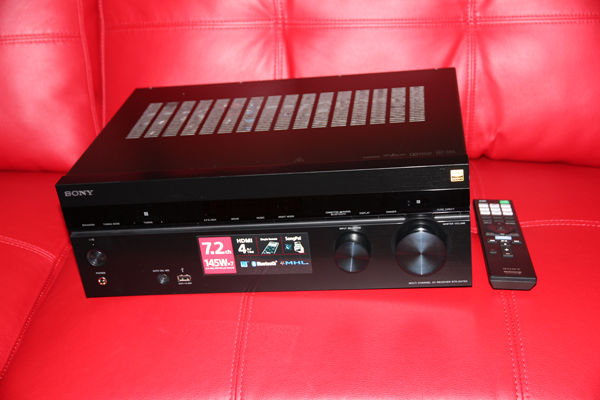As a starting point of this review Home Audio has always been an interest of mine, even from a young age where I would sit for hours listening to records on my fathers component system. So naturally when I was asked if I wanted to do a Product Review on the Sony STR-DH750 Receiver I had to snap up the opportunity right quick! Over the last few weeks I have spent numerous hours listening to music, testing features and demoing the unit to several customers watching for their reactions and also at the same time seeing how they responded to the functionality of the Sony STR-DH750.
Ok, lets start with the product design…
When it comes to the Sony Receivers design they have a tendency to have a simple layout or look, this to me is a good thing as I am not a fan on lots of buttons and also this can be good for the general public or technologically disadvantaged. However when you have a screen connected the menu’s become a lot more involved which is good, giving the user the option to either have a nice simple display or a more complex one.
Even the remote is of simple design with more than enough buttons for the user but not confusing cluster of buttons that you would most likely never use.
Now lets get to my favourite part… Sound Quality
Ok, I will admit I wasn’t actually expecting to much from the output or sound quality of the Sony STR-DH750, but these are words that I have had to take back…
Between Ashley and myself we have spent a lot of time in the last month or so playing different genres of music on the Sony STR-DH750 with different speaker types and configurations. The overall sound is very clean even at the higher levels, keeping in mind the output is a very conservative 90 watts per channel with 0.09% THD or 145 watts x7 channels with 0.9% THD. I’d go as far as it sounds better and cleaner than another amplifier that I have been testing that claims almost twice the rated power and almost twice the price point.
Specifications
Receiver
Amp channel: 7ch
6 Ohms 20-20 kHz: 90W + 90W
(6 Ohms 20-20 kHz) THD: 0.09%
Analog Direct: Yes
Bi-Amp: Yes
Speaker Selector: A/B/A+B
Speaker Terminal: Screw
Headphone Out: Yes (Gold)
Connectivity
HDMI input: 4
Composite input: 1
Optical: 2
Coaxial: 1
Analogue Audio in: 2
USB: 1 (iPhone/WM via USB)
USB support formats: MP3, AAC, WMA, WAV 192k, FLAC 192k, ALAC
MHL: 1
HDMI output: 1
Composite Monitor Out: 1
Headphone out: Yes
Pre-out (subwoofer): 2
Sound Decoding Format/Sound Field
DSD: Yes (HDMI)
LPCM (2ch/5.1ch/7.1ch) thru HDMI: Yes
DTS HD MA/ DTS HD HR: Yes/Yes
Dolby True HD/Dolby Digital Plus: Yes/Yes
DTS / DTS-ES MATRIX 6.1/DTS-ES DISCRETE 6.1: Yes/Yes/Yes
DTS 96/24: Yes
Dolby Prologic/II/Iix: Yes/Yes/Yes
Dolby Dual Mono: Yes
2ch: Yes
Analog Direct: Yes
A.F.D. (Auto Format Direct): Yes
Multi Stereo: Yes
HD Digital Cinema Sound: Yes
PLII Movie: Yes
PLIIx Movie: Yes
Neo: 6 Cinema: Yes
Hall sound mapping: Large hall
Jazz Club: Yes
Live Concert: Yes
Stadium: Yes
Sports: Yes
Portable Audio Enhancer: Yes
PLII Music: Yes
PLIIx Music: Yes
Neo: 6 Music: Yes
Advanced auto volume: Yes
Night mode: Yes
A/V Sync: Yes (fixed)
HDMI Quality
1080p: Yes
1080/24p: Yes
Deep Colour: Yes
Triluminous Colour: Yes
3D over HDMI: Yes
Audio Return Channel: Yes
Audio Widget: Yes
BRAVIA Sync (CEC Control): Yes
Tuner
Preset Channel (FM/AM): FM 30/AM 30
Station Name: Yes
Auto Tuning: Yes
Direct Tuning: Yes
Networking
Bluetooth: Yes
NFC: Yes
Mobile application: Song Pal
Other Features
Auto Room Tuning Mic: Advanced D.C.A.C.
GUI: Basic
Sleep Timer: Yes (up to 2 hours)
Dimensions (W x H x D mm): Approx: 430 mm x 156 mm x 329 mm
Weight: Approx: 7.6 kg
Power Consumption: 240 W
Power Consumption (stand by): 0.3 W
Auto Standby: Yes
Some History of Sony’s Home Audio
1950:
Type G

Japan’s first tape recorder. This machine featured a tape speed of 19cm per second. With Sony’s exclusive small-hub reel, the recorder accepted tapes in reel diameters of up to 10 inches. Units were delivered to the Supreme Court and various other government agencies, earning it the nickname “Type G,” for government.
1951:
H-1

The first consumer-use tape recorder. It was named “Type H,” for home, because it was designed for home use. The machine was housed in a wooden case resembling a trunk to accommodate overseas travel. It weighed 13kg, much lighter than the first-generation Type G. This was the first model to incorporate industrial design.
1961:
TC-777

Japan’s first all transistor amp tape recorder. Because the model name had a series of three sevens in a row, it was called the “Three Seven.”
1964:
TC-263D

Tape deck featuring only a single transport mechanism. This device was unique in that it used a recording amplifier known as the SRA-3 to record sound, with reproduction achieved by connecting a tape playback equalizer to the same amplifier. Since music was generally reproduced only from phonograph records at the time, this product was revolutionary in that consumers could now enjoy music on tapes in the same way they had with vinyl records.
1965:
TA-1120

The world’s first all-silicon transistorized stereo integrated amplifier. It was the first product in the ES series. This device caused a sensation throughout the audio industry due to its ability to offer what vacuum tube amps could not: major output while simultaneously ensuring low distortion.
1970:
TC-9000

Stereo tape deck utilizing one-way 2-track stereo recording instead of conventional reciprocal 4-track stereo recording, with a tape speed of 38cm per second (about twice that of conventional models). Together, these features provided advanced performance similar to professional equipment. This tape deck enjoyed popularity among audiophiles under the nickname “Two-track Three-eight.”
1972:
Listen 5

Part of Sony’s “Listen” series and one of the earliest component stereo systems.
1973:
TC-2850SD

The first “Cassette Densuke,” successor to the shoulder-type tape recorder nicknamed “Densuke.” Although portable, this tape recorder also offered such high performance, it was also used as a stationary model. This product coincided with a fad for the nostalgia of steam locomotives known as the “SL Boom.” A craze for on-site recording was set in motion and the TC-2850SD played a leading role in this craze.
1977:
PCM-1

Enabled users to record digitally by connecting with a consumer-use VTR. This device played a notable role in audio history in that now even amateurs could handle PCM (pulse code modulated music source) technology, previously limited to professionals. This technology would eventually lead to the development of the compact disc.
1982:
CDP-101

World’s first compact disc player. The 12cm CD, on which music signals were digitally recorded, signaled the birth of advanced high fidelity sound, opening up new horizons for digital audio.
1987:
DTC-1000ES

Digital Audio Tape recorder (DAT). This deck enabled users to enjoy advanced high fidelity audio recording and reproduction at home.
1999:
SCD-1

The first Super Audio CD (SACD) player, representing the latest in the realistic reproduction of sound, enabling playback of even the most minute nuances and atmosphere of high fidelity music.
2004:
NAS-A1

Network audio system offers compatibility with the Japan-based “Any Music” service—enabling users to enjoy purchasing and downloading music CDs via the net.
2008:
NSA-PF1

2009:
TA-DA5500ES

TA-DA5500ES, world’s first multi – channel integrated amplifier with automatic phase – matching technology
2010:
STR-DH710

Home Theater A/V receiver capable of supporting HD components including 3D and ARC.
2011:
TA-DA5700ES

The world’s first* 9.1ch playback-compatible 7-channel integrated amplifier equipped with ‘Sound Optimizer’ correction technology.
* As an independent correction technology based on the difference between the efficiency measurement of multi-channel integrated amplifier speakers and the standard movie production levels. (Current at the time of the press release issued on September 28, 2011.)
Pro’s/Con’s
Pros: Good clean power, easy to use, beautiful clean design, dual subwoofer outputs
Cons: Would like more HDMI input/outputs, no pre-outs to run power-amps.
Overall the Sony STR-DH750 has decent output that is nice and clean sounding, 7.2 sound for all your movie needs and is 4k through capable. Nice and easy to use USB, Bluetooth and has a very big bang to buck ratio making very appealing for anybody just starting to build their own surround sound or musical setup!
Lance ‘Captain Z’ Wilson
